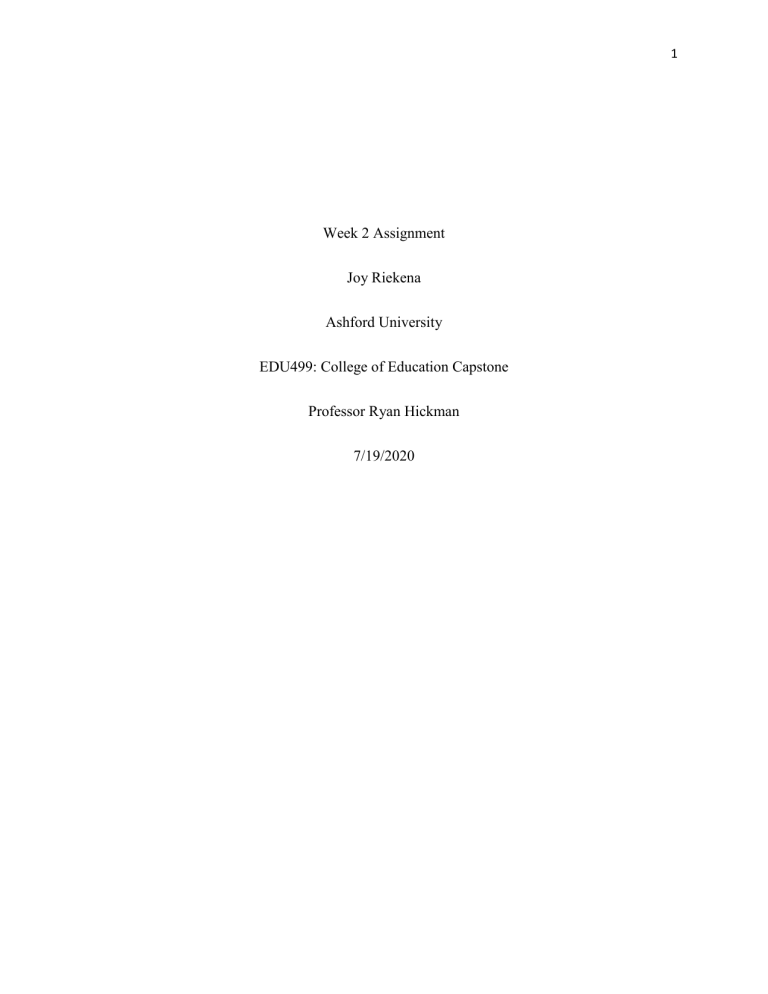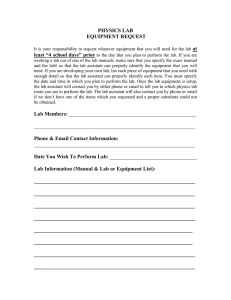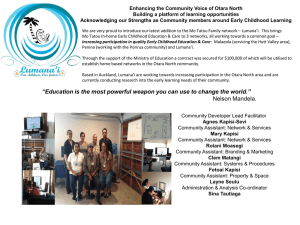
1 Week 2 Assignment Joy Riekena Ashford University EDU499: College of Education Capstone Professor Ryan Hickman 7/19/2020 2 Hello, My name is Joy Riekena, I have just completed my BA in Early Childhood Education. I am applying for the position of Activities Coordinator, at your multigenerational learning facility. I believe I am the perfect candidate for the job because I have over 10 years of experience working with children and families, I am passionate about doing what is best to help each child grow, and I am a team player. Describe your views of assessment of young children. What kinds of records would you keep for monitoring student progress? I have mixed views about child assessments. I believe we need to know what the child knows to know what to teach them, but I also believe that adult child interactions and play are the most important way for children to learn. If assessments take a child away from those valuable moments, then I feel that their overall value is diminished. “The value of an assessment is a function of its capacity for generating novel or unexpected information; therefore, assessments should be questioned to the extent that they are a source of redundancy, regardless of psychometric considerations” (Downs & Strands p. 8, 2006) I believe that assessments of young children are best done by recording observations and then using those observations to assess a child’s skill level. I have experience using both Teaching Strategies Gold, and COR advantage as a method of recording and analyzing data. When it comes to things like alphabet recognition, I will assess the child with flash cards, only if the child is able to focus. This means it may take more than one day to gather the data. Because of the unpredictability of children. I have a pacing guide for myself to follow, so that I can focus on observing different objectives at different times throughout the year. In addition to classroom 3 observations I also send home Ages and Stages Questionnaires to families every 6 months, this acts as additional data and insight into the child’s progress. “The original ASQ has been proven to be reliable and valid with an overall sensitivity of 75% and specificity of 86% in detecting developmental delays” (Lamsal, Dutton, & Zwicker 2018). What five items would you put into an empty classroom? And Why? 1. Sensory Table – “Sand play promotes physical, cognitive, language, and social-emotional abilities, including fine and large motor skills, cooperative building, sharing, and pretending” (Jarrett, French-Lee, Bulunuz, & Bulunz, 2010). Sensory stimulation such as sand and water can help children regulate their emotions as well as benefiting other areas of learning as well. NAEYC guidelines say that children should have access to sand and water play every day. 2. Calm corner or “Safe Space” I like to use conscious discipline in my classroom, one of the essential components of this is having a place for a child to go if they need a break, want to be alone, or need to calm down. This space is never used as a time-out and the child is always free to enter and exit at their own will. I have found that once children grasp the understanding of what it is for, this space becomes an essential component of the classroom environment. “A quasi-experimental study found that children enrolled in Conscious Discipline classrooms showed significantly greater reductions in externalizing behavior problems compared to peers in control classrooms” (Anderson, Wiemer, & Fuhs 2020) 3. Alphabet and Number manipulatives – Not all children are going to be visual learners, it is important to include tactile representations of concepts that children can touch, hold, and examine. For example, I would play a game called “What’s in the sack” the children 4 will feel what is inside and take a guess. One student who always preformed poorly on standard assessments, could identify the numbers and letters just by feeling them. This gave him an opportunity to shine and really boosted his confidence. 4. Loose Parts – I absolutely love loose parts, even before I knew what they were called. As a child I can reflect on some of my most memorable play experiences being with ordinary objects that were never marketed to children. “loose parts are so open-ended, they can support play for children of every cultural background, class ability, and gender” (Daly & Beloglovsky, 2015, p.23). 5. Books – High quality books should be available in every area of the classroom. Including books that are representative of the children who will be learning in the environment. Books about various cultures, non-fiction, and fiction books, as well as books without pictures all have an important part in the classroom. As the year progresses, I like to encourage the students to create their own books to add to the classroom libraries. Describe a time when you have had to deal with an upset parent. How did you handle the situation and what was the outcome? One thing I am very good at is remaining calm, even when someone is angry with me. Many people tend to become defensive in these situations, but I like to strategize and de-escalate as much as possible. This past year I had a mother who was very particular about the way her child looked. One morning she stopped me and asked me to come into the hallway. She proceeded to ask me why her daughter was coming home with paint on her clothes every day. She also complained that the paint was not washing out of her clothes. Now I could have argued that kids will be messy and do not send her in nice clothes if you do not like it. I also could have said that I know the paint is washable, I have used the same paint for years and washed it out of my own 5 clothes. What I have learned though, is to accept that different families and cultures have different values, and some of them value dressing their child and having them look a certain way. My response to her was to apologize, and to acknowledge her feelings. “I am so sorry the paint isn’t washing out of your child’s clothes, that must be really frustrating.” I then followed it with a solution, “From now on I will be diligent in seeing that she wears a paint shirt during messy activities”. The result was the mother immediately calming down, thanking me, and moving on. I also followed through with making sure her daughter wore a paint shirt for the rest of the year. As a leader with an assistant, how would you encourage an effective partnership and support your assistant? A teacher and assistant should be working as a team. I will let my assistant know my policies and preferences, and I will listen and consider any feedback I receive. When I do make a recommendation for changing something, I explain the reasoning behind it. For example, when I started my current job I noticed immediately that the assistant teacher would instruct students to say “no, thank you” when ever they did not like what another student was doing. Without undermining her while she was in the process of dealing with a conflict I came over and showed her how to have the child tell the other child what they did not like, and what they wanted the other child to do. Then I explained the reasoning behind doing that. When planning lessons, I always ask my assistant if she had any ideas, she wanted me to incorporate, in addition to that I give her something to “own”. My current assistant really likes doing crafts with the children. I personally never plan crafts, as I prefer process art. Instead of telling her not to do them, I set aside times in the afternoons when she can do crafts with the children. These do not interfere with our regular teaching schedule, and the kids really seem to 6 enjoy it. I will also assign certain children for my assistant to take notes or observations on, so that I can focus on more challenging students. How do you stay updated on news and innovations in the field of early childhood education? I attend many professional development sessions. I attended NAEYC June 2019, and MIAEYC in 2017. In addition to that I have completed the S.E.E.D.S series, and the math track series provided by the Kent ISD. I have never been short on my required professional development hours, instead I am usually well above 24. I also love to read any new material that I find about Early Childhood, it is always possible to learn something new. Conclusion As you can see, I have experience with many different situations. I am knowledgeable about best practices in Early Childhood, and I am excellent at communicating with families. I strongly wish that you will consider me for this position. I feel like I would be an asset to your organization. 7 References Anderson, K. L., Weimer, M., & Fuhs, M. W. (2020). Teacher fidelity to Conscious Discipline and children’s executive function skills. Early Childhood Research Quarterly, 51, 14–25. https://doi-org.proxy-library.ashford.edu/10.1016/j.ecresq.2019.08.003 Daly, L., Beloglovsky, M., Daly, J., & Handrigan, J. (2015). Loose parts: inspiring play in young children. Redleaf Press. Downs, A., & Strand, P. S. (2006). Using Assessment to Improve the Effectiveness of Early Childhood Education. Journal of Child and Family Studies, 15(6), 671–680. https://doiorg.proxy-library.ashford.edu/10.1007/s10826-006-9080-7 Jarrett, O., French-Lee, S., Bulunuz, N., & Bulunuz, M. (2010). Play in the Sandpit: A University and a Child-Care Center Collaborate in Facilitated-Action Research. American Journal of Play, 3(2), 221–237. Ramesh Lamsal, Daniel J. Dutton, & Jennifer D. Zwicker. (2018). Using the ages and stages questionnaire in the general population as a measure for identifying children not at risk of a neurodevelopmental disorder. BMC Pediatrics, 18(1), 1–9. https://doi-org.proxylibrary.ashford.edu/10.1186/s12887-018-1105-z


